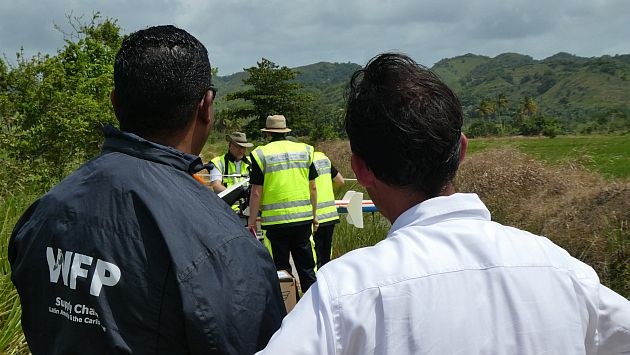Unmanned helicopter superARTIS delivered humanitarian goods

During the second week of the pilot operation in the Dominican Republic, the superARTIS team performed different humanitarian delivery missions together with Wings for Aid and the World Food Programme. The flights took place in an area called 'Bajo Yuna', which suffers from frequent flooding and related 'last mile' delivery problems. These flight tests are one of the founding stones to connect DLR's UAS projects with applications in humanitarian technology.
One week passed with successful flights, during which our helicopter drone superARTIS delivered humanitarian goods by dropping them in an innovative box of Wings for Aid. This week, we moved to an area called Bajo Yuna. It is located in the northeastern part of the Dominican Republic. During our pathfinding mission in May, we learned from the World Food Programme (WFP) and Red Cross representatives that this area is often flooded, which leads to the isolation of communities that require support. Hence, we chose this area to test the concept of our humanitarian delivery. We identified different mission profiles. These missions are inspired by past incidents to yield representative scenarios. This enables us to derive the data needed for the project, including operating the drone beyond visual line of site. We had a tight schedule, as several missions were planned. Would the weather last?
On Monday, we started with the first mission, which covers a distance of about 800 metres to deliver the humanitarian aid to a farm at the border of the village Barraquito. It turned out that there was no need to worry. The previous week’s experience expedited the entire planning and execution of each flight. Already on Monday, we completed the first mission scenario several times. However, we were not quite happy with the drops of the boxes. What did we do wrong? They worked perfectly last week, but now some of them did not unfold as expected. Was something wrong with our procedures, did we change something since Jimani that we did not notice? As the mission itself was successful, we moved forward to the next mission on Tuesday.

Here, we covered a longer distance of around 3.5 kilometres. The take-off was close to a small town called Arenoso, and the flight route took our helicopter over rice fields to a village that suffers from the floods in this area very often. Again, we performed the mission several times successfully. By this time, we had already achieved a certain routine in preparing and planning the mission – an indication that this concept of helicopter and box is applicable to the real situation. But the boxes still did not perform well in all of the drops. Many hypotheses were identified and we assisted the Wings for Aid team in modifying them. And again, some deployed their wings properly and some did not. This puzzled us as we have conducted many tests in Germany already with close to 100% success rate.
As such, we decided to spend our last day of flight testing on the boxes themselves in order to gather drops and corresponding data. What was the source of the boxes' behavior? Was it the different climate in the Dominican Republic compared to Germany, or simply a change in manufacturing of the boxes? Carefully and systematically, we tested all the modifications we had performed thus far. As a result, we ended up with a configuration that now works perfectly. This new design will improve the flight of the box in differing operational conditions and climate situations in the future.

We can now return home with a great deal of successful missions and many lessons learned. The boxes now also work perfectly within the operational conditions in the Dominican Republic, and the mission planning and execution is proven to work in situations where people do not have access to supplies. Every mission had its own built-in challenges, be it a difficult take-off location, difficult communication situation between dropping site and the operating crew, or additional coordination needed to secure the take-off, flight and delivery areas. The team returned quite tired from the long weeks of operation, but proud and happy as well. We have all we need to connect the results of this mission with our research projects developing drones for humanitarian aid.
In parallel, the helicopter and equipment also returned home. The transportation and customs clearance itself is such a complicated task that it has actually been a project in itself. Many thanks to Wings for Aid and Rhenus logistics for tackling this challenge and for running this great project together!

Tags:
